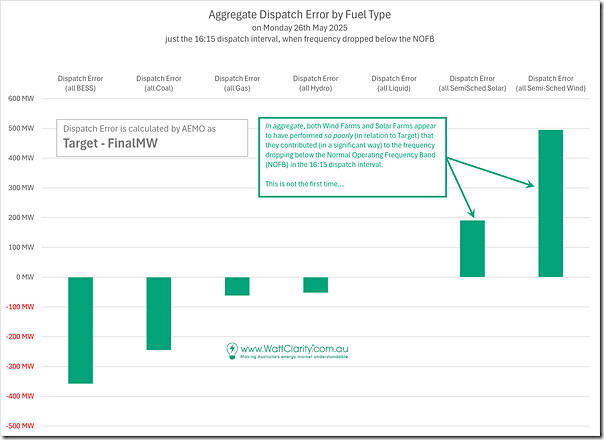Yesterday, Linton wrote about the ‘Drop in mainland system frequency on 26 May 2025’ … noting in particular the frequency dropping significantly through the 16:15 dispatch interval to the point where it dropped outside of the NOFB shortly into the next dispatch interval:
1) presumably triggering Contingency FCAS response.
2) which is not the first time we’ve seen this occur (due to similar cause).
Time permitting in a later article I’ll come back and review in more detail for the whole day (in part because it was very windy, so an interesting broader case study), but here’s a single chart about the 16:15 dispatch interval (NEM time) that shows the aggregate ‘Dispatch Error’ calculated across all types of plant that are either fully Scheduled, or Semi-Scheduled:
Readers should keep in mind that a positive dispatch error (or a negative dispatch error) is not inherently better (or worse) than the other direction … one needs to keep the frequency requirement in mind, especially given the added incentives (and requirements) of Primary Frequency Response. But in this dispatch interval note that Linton’s chart showed that the frequency started at ~50Hz at the start of the dispatch interval, and ended up at ~49.85Hz … which means that (in this instance):
1) Any unit (or fuel type as a whole) that was producing a negative Dispatch Error was trying to boost the frequency … which was what was required;
2) However any unit (or fuel type as a whole) that was producing a positive Dispatch Error was like a drag on frequency, forcing it lower … was like part of a rowing team circling their oars in the opposite direction of desired travel.
My suspicion, without looking in detail at this instance (but having looked at many instances of poor AggROT across all Semi-Scheduled units in the past), is that there might have been at least these 3 factors at work:
Issue #1) First and foremost, this speaks to the ongoing challenges in forecasting VRE.
… speaking to the underlying question of ‘Is VRE forecastable?’
Issue #2) The above is compounded by the current allowance for VRE to operate as only Semi-Scheduled.
… speaking to the underlying question about ‘is the Semi-Scheduled category sustainable or scalable?’
Issue #3) The above might have been further compounded by perverse incentives in self-forecasting.
… which lead to the ‘games that (some) self-forecasters can play’.
I’ll be in the Brisbane Session of the Nelson Review discussion tomorrow morning and will be very interested to hear whether the Nelson Review Panel members are tackling these vexed issues … for surely we need all participants in the rowing boat to be rowing in the same direction in order to get to any target (whether it be at 2030 or 2050).



Leave a comment